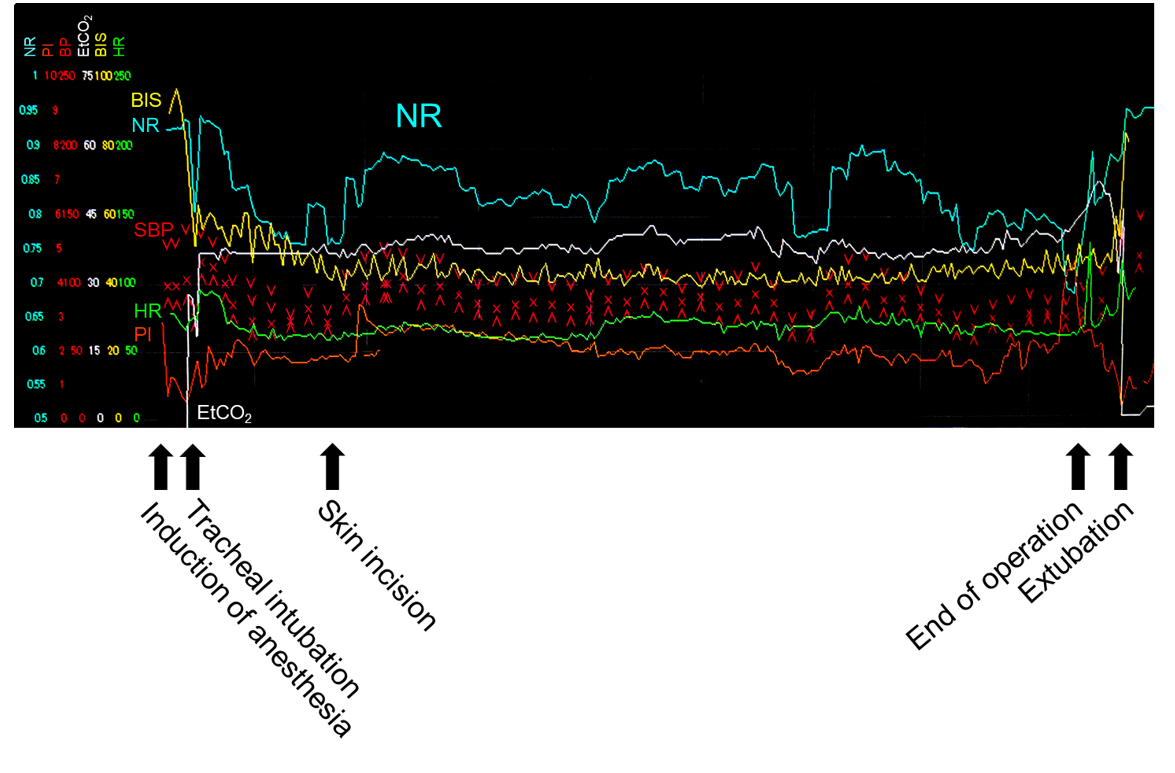Development of a general anesthesia index (NR) to reduce the risk of postoperative complications
Information updated: July 31, 2023
- Seeds Information
- Researcher Information
- What do you expect from collaboration with companies?
- Contact for this research
Seeds Information
keyword
Surgical stress, nociception
Field
Perioperative management, Department of Anesthesiology
Overview
The occurrence of postoperative complications due to surgery affects not only the short-term prognosis but also the long-term prognosis of patients, so there is a need to suppress their occurrence. Although efforts have been made to improve the overall condition of patients before surgery, develop minimally invasive surgery, and implement early postoperative recovery programs, serious postoperative complications still occur in several percent to several tens of percent of patients. One of the factors that causes postoperative complications is the intensity of surgical stress, and we thought that suppressing the biological reaction to surgical stress through anesthesia management could contribute to suppressing postoperative complications. However, there has been no indicator to quantitatively monitor surgical stress during surgery.
In this study, we developed the Nociceptive Response (NR) index, which quantifies the strength of nociceptive stimuli during general anesthesia using heart rate (HR), systolic blood pressure (SBP), and perfusion index (PI) (Formula (1)). The change in the NR index in an actual clinical setting is shown in the figure. The purpose of this study is to clarify that anesthesia management that suppresses the NR index during surgery suppresses biological reactions due to surgical invasion and suppresses the onset of postoperative complications.
What's new?
We have discovered the first mathematical formula that can objectively evaluate the strength of nociceptive stimuli during anesthesia.
In addition, it is now possible to display the strength of nociceptive stimulation during anesthesia in real time during surgery as a calculated numerical value, NR.
What are its advantages over other studies?
Since it uses normal monitor values, it is easy to obtain the NR value and can be applied to existing monitors, making it extremely versatile.
Retrospective evaluation is also possible using big data accumulated in anesthesia monitoring and recording devices.
What problem does it help solve?
General anesthesia presents the challenge of reducing risks to patients, such as the occurrence of postoperative complications.
- The anesthesiologist will administer the appropriate amount of anesthesia.
- General anesthesia management that suppresses the NR index value during surgery (NR-guided general anesthesia) contributes to preventing the onset of postoperative complications.
Possibility of other applications and developments
By quantifying "pain level," it is possible to provide appropriate analgesia to patients receiving intensive care.
Related Patents
Patent No. 6934251 "Apparatus and method for monitoring nociceptive stimulus response levels under anesthesia" (Registration date: August 25, 2021)
Related papers
- J Clin Med. 2022;11:6080.
- J Clin Monit Comput. 2022; 36: 1519-1524.
- Reg Anesth Pain Med. 2022; 47: 494-499.
- Eur J Anaesthesiol. 2021; 38: 1215-1222.
- J Clin Monit Comput. 2022; 36: 1519-1524.
- PLoS One. 2020; 15: e0239709.
- Sci Rep. 2020;10:15300.
- J Clin Monit Comput. 2021; 35: 499-503.
- J Surg Res. 2020;249:13-17.
- PLoS One. 2019; 14: e0226032.
- J Clin Monit Comput. 2020; 34: 575-581.
- Med Sci Monit. 2019; 25: 3140-3145.
- Med Sci Monit. 2018; 24: 3324-3331.
- J Anesth. 2015;29:967-70.
Researcher Information
| full name | Munetaka Hirose |
|---|---|
| Affiliation | Department of Anesthesiology and Pain Science, Faculty School of Medicine |
| Specialization | Perioperative management, Department of Anesthesiology |
| Collaborative Researcher | Nobuyuki Kariya, Ryusuke Ueki, and Hiroaki Okutani |
| Related links | Laboratory website |
What do you expect from collaboration with companies?
Collaborating with medical monitor manufacturers and distributors to conduct joint research into the usefulness of installing the technology on monitors and managing NR values
Contact for this research
兵庫医科大学 大学事務部 研究推進課
E-mail: chizai@hyo-med.ac.jp
Tel: 0798-45-6488

 Research Seeds Collection
Research Seeds Collection

